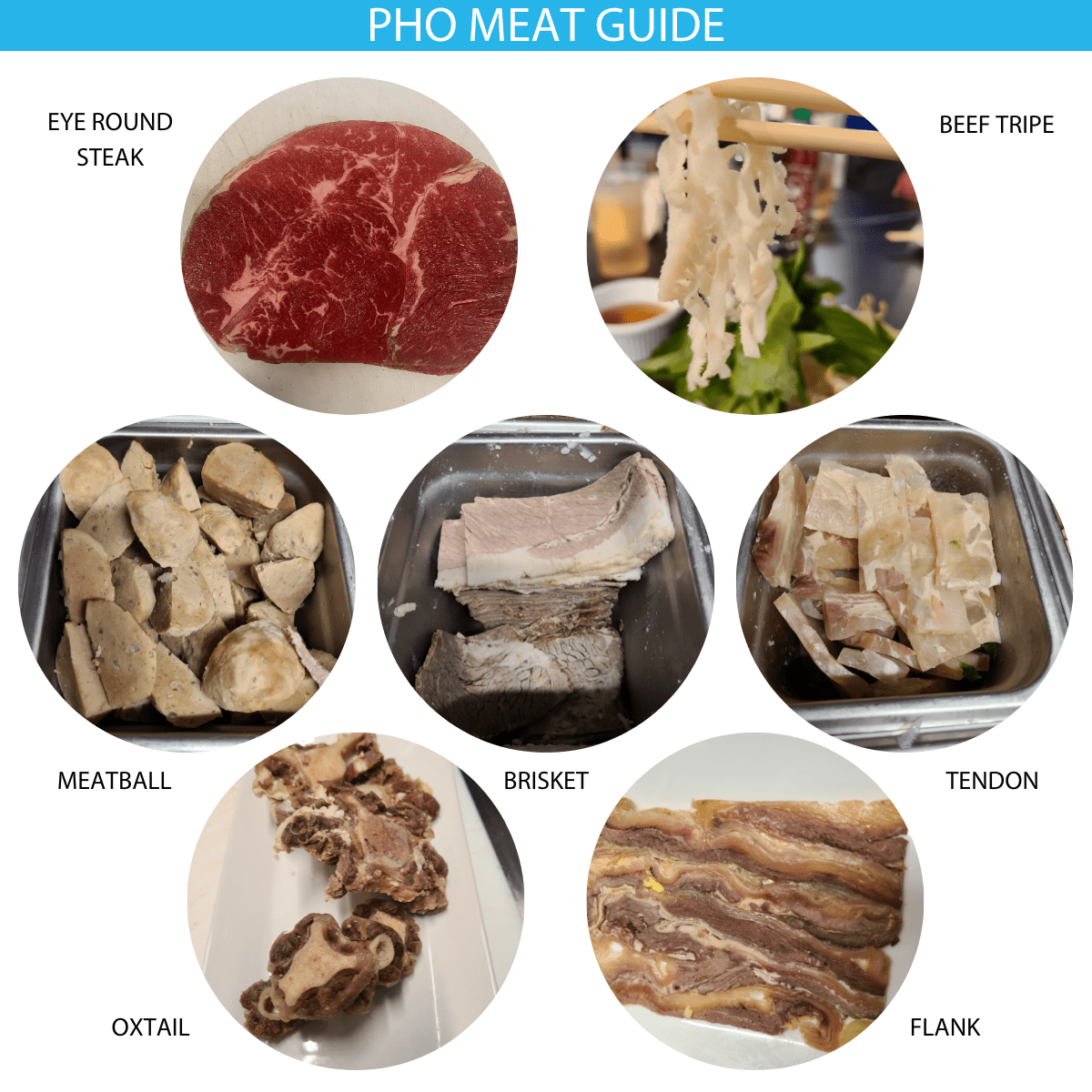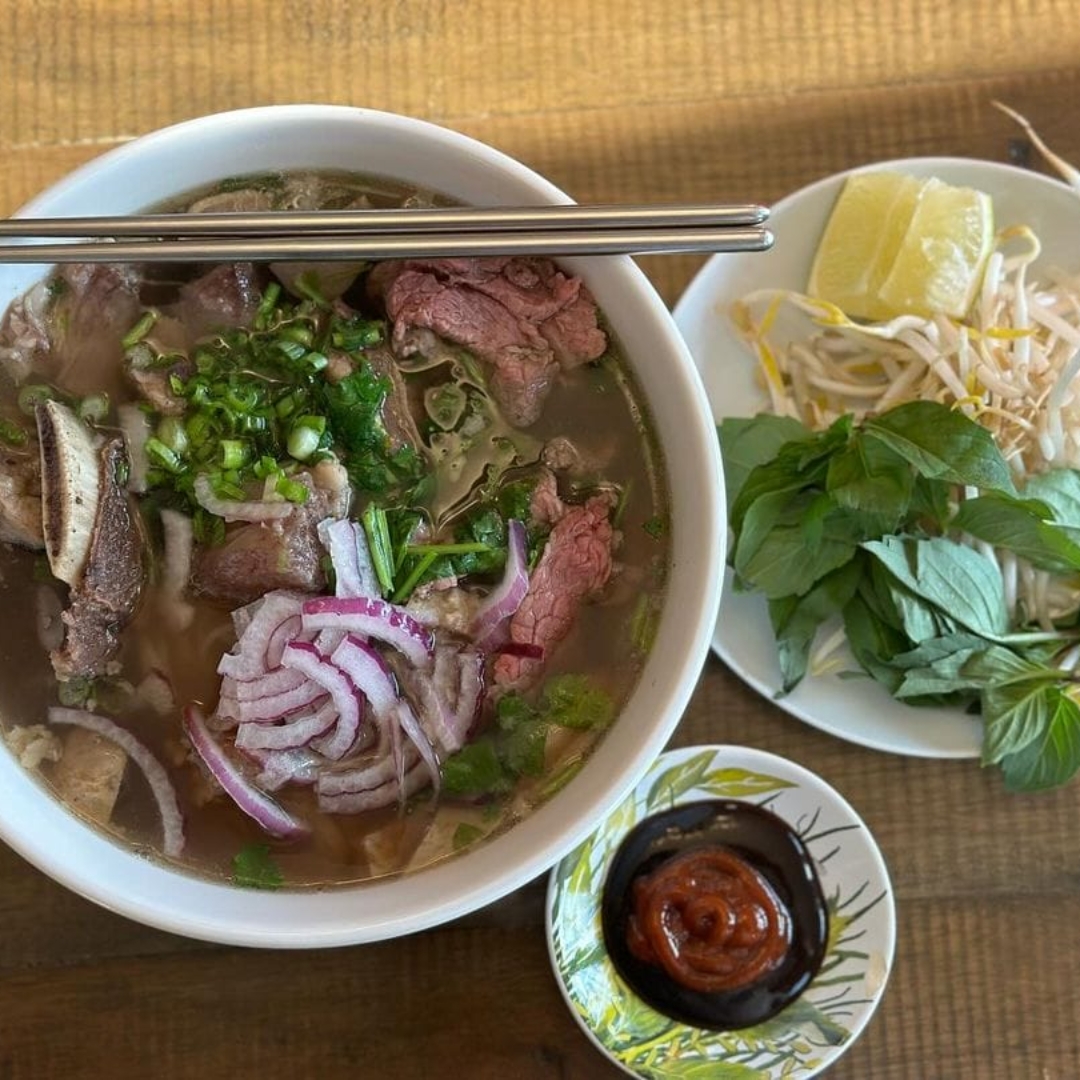Vietnamese foods are often quite flavorful. This Pho meat guide is a must-read before your next visits to the nearest Pho restaurant. You might want to take a screenshot of the above picture for reference.
Pho is very healthy soup with rice noodles. Its health benefits is primarily due to the fact that it is a form of bone broth that’s been flavored with nutritious herbs.
Jump Ahead
- Jump Ahead
- What is Pho?
- How to Pronounce Pho
- What is In Pho?
- What is the Broth Made Of?
- Pho Meat Guide
- Best Meat for Pho – (at the restaurant)
- Most Common Pho Meat is Round Eye Steak
- Best Meat for Pho (for the home cook)
- Pho Types
- Is Pho Healthy?
- How To Eat Pho Like a Pro
- FAQ
- You might also like
- Are you at a Pho Restaurant? Download Our Cheat Sheet for ordering Pho right now!
What is Pho?

Pho is the national dish in Vietnam. It is a Vietnamese noodle soup that is filled with sliced meat. The meat is usually beef.
No one is quite sure when pho originated in Vietnam. However, it is thought to have first been made in the early 20th century in Northern Vietnam. It entered Southern Vietnam in 1954. It wasn’t until after the Vietnam War that it was introduced in other countries.
You can always find beef pho in a Vietnamese restaurant. There are a few types of pho though. If you ask around, you may be able to find chicken pho.
How to Pronounce Pho
If you have never heard of pho before, you may have no idea how to pronounce it. Pho is pronounced “fuh”. This is different than what many people think, since so many people call it “faux”.
What is In Pho?
Pho normally contains bone broth, rice noodles, and the beef we mentioned above. Sometimes it is served with garnishes such as scallions and yellow onions. Child sized noodle soups will usually exclude these garnishes unless you request them.
Other Pho toppings can include bean sprouts, a lime wedge, chiles, or fresh herbs. Typically you get these on a separate plate at the restaurant when you order your Pho.

Related Article: If you’re curious about how other noodle dishes stack up, take a look at our comparison in the “Chow Mein vs Lo Mein” article to explore the differences between these two popular dishes.
What is the Broth Made Of?
The hot broth used in pho is made from beef bones. Shank and knee beef bones are usually the preferred bones for the stock. You can use other beef bones though.
To make the bone broth, take a large stockpot and set it on the stove. Add in the beef bones, charred onions, salt, ginger, star anise, and fish sauce (on Amazon). Cover all that with approximately four quarts of water.
The bone broth must simmer for at least six hours. It is better if it can simmer for 10 hours though, because it will be more flavorful.
While this rich broth is for pho, you can have a bowl of broth by itself. It will taste delicious and has numerous health benefits.
Pho Meat Guide
There are many different types of raw beef used in pho. You can easily order a bowl of soup that has your favorite cuts of meat in it.
Rare Beef – Tai

The rare beef used in pho is normally round eye steak that is thinly sliced. Ribeye or tenderloin can also be used for tai pho meat. These tender thin slices of beef offer a clean beefy flavor.
It is a popular choice to order your Eye Round Steak “on a side” – it comes out raw, and you can cook it yourself with the piping hot Pho broth to your liking, or eat it as is after “cooking” it with plenty of lime.
Due to it being thinly sliced, this steak will come out well done unless you order it on a side.
If you’ve never done it before, it would surprise you to see the lime juice literally “cook” the rare steak as you squeeze the lime on it. It turns gray right before your eyes. I normally don’t eat it this way, but I do prefer to cook it in the hot broth myself so it’s medium-rare instead of well done.
Brisket – Gau
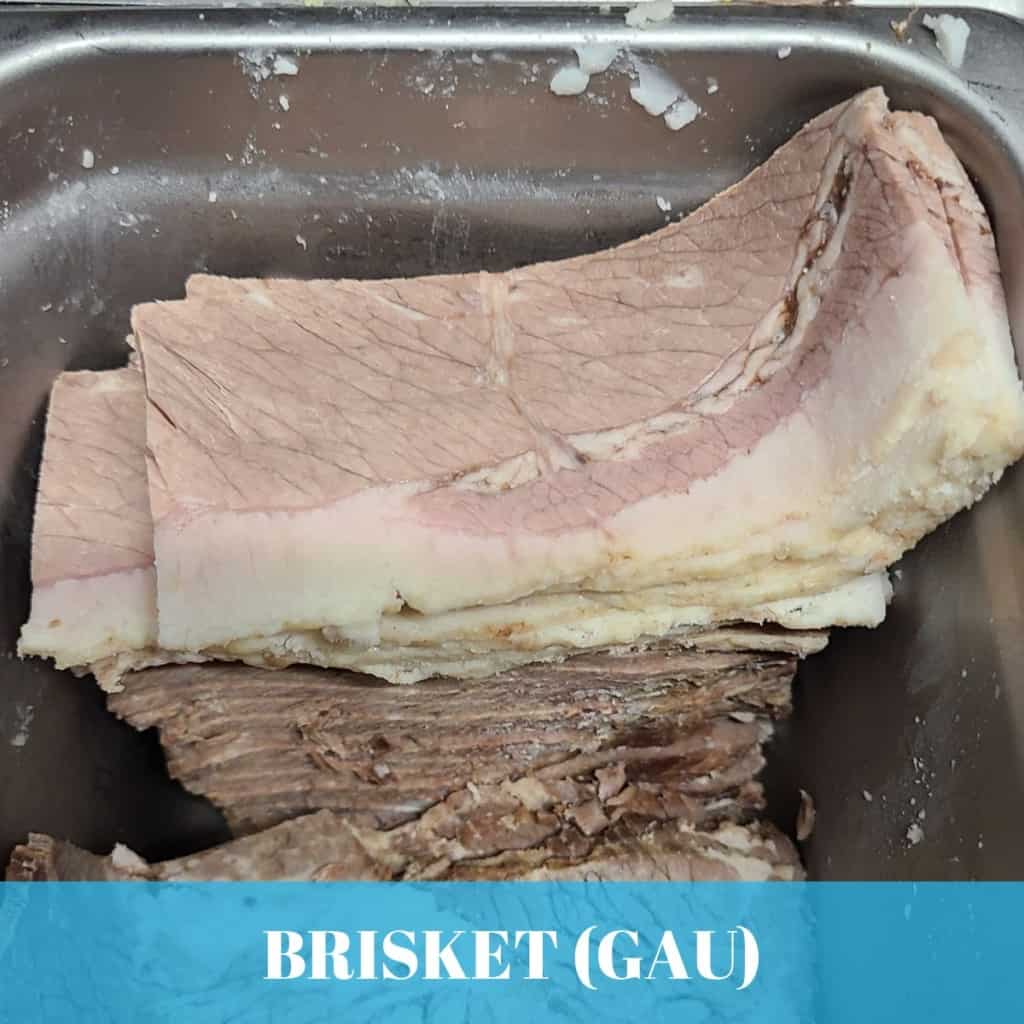
Brisket comes from the cow’s chest. This meat is basically alternating layers of fat and meat. We prefer to get brisket from the point or deckle of the cow. Those briskets are fattier and full of flavor.
Flat lean brisket doesn’t have as much fat as the fatty brisket, so they don’t bring as much flavor to pho.
Tendon – Gan
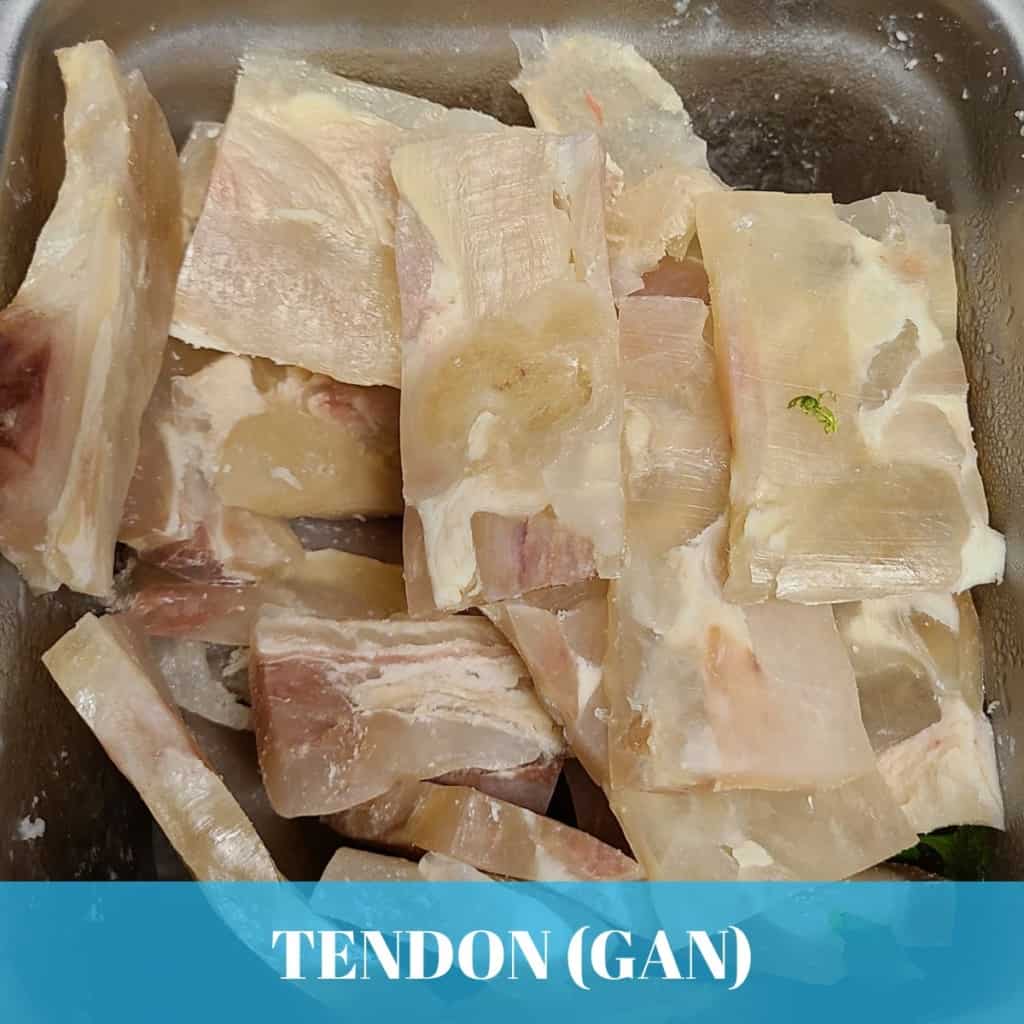
The tendon pho meat, or gan, comes from the thick strong tendon that runs down the back of the shank. It offers lots of texture with a neutral flavor. It’s soft and easy to eat – but the soft texture might be a bit foreign to you. Try it and you might like it!
Love organ, tendons, and believe that we should eat “the whole animal”? You won’t want to skip this part! I can’t think of a lot of dishes that would offer this part of the cow in a delicious broth.
Flank – Nam
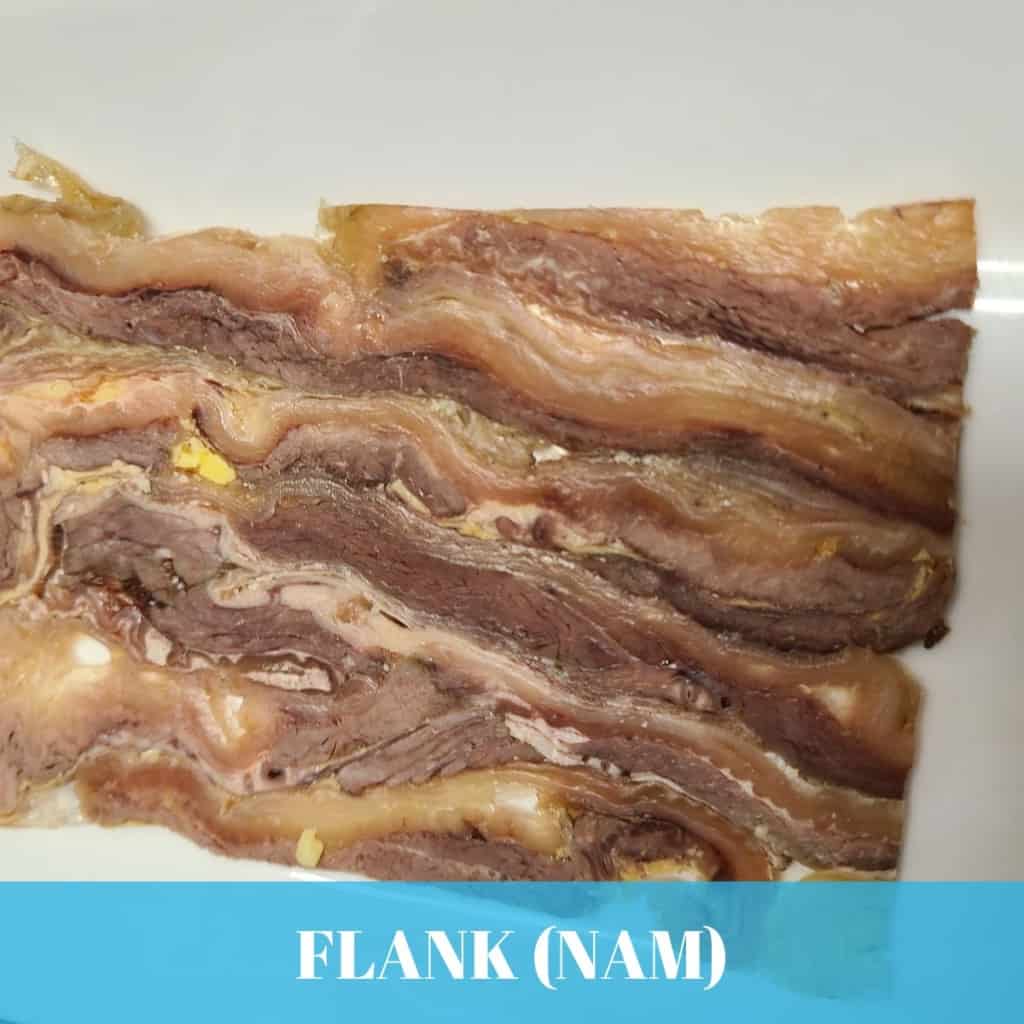
Flank steaks come from the underside of cows, near the hind legs. This type of beef can be tough, but it is full of beefy flavor. When it comes in Pho, however, it is thin sliced so it won’t be as chewy.
In an interview with Nguyen Do, owner of the at Pho So 1 Boston Restaurant franchise in Boston, MA for over 20 years, the flank that he buys is “rough flank” – which is not your typical flank steak bought at the butchery in grocery stores.
Rough flank has more sinews, tendons, and cartilage – very tough to eat, but when it is sliced very thinly and boiled before serving, it is actually soft and a bit chewy but not “tough”.
Oxtail – Dui Bo
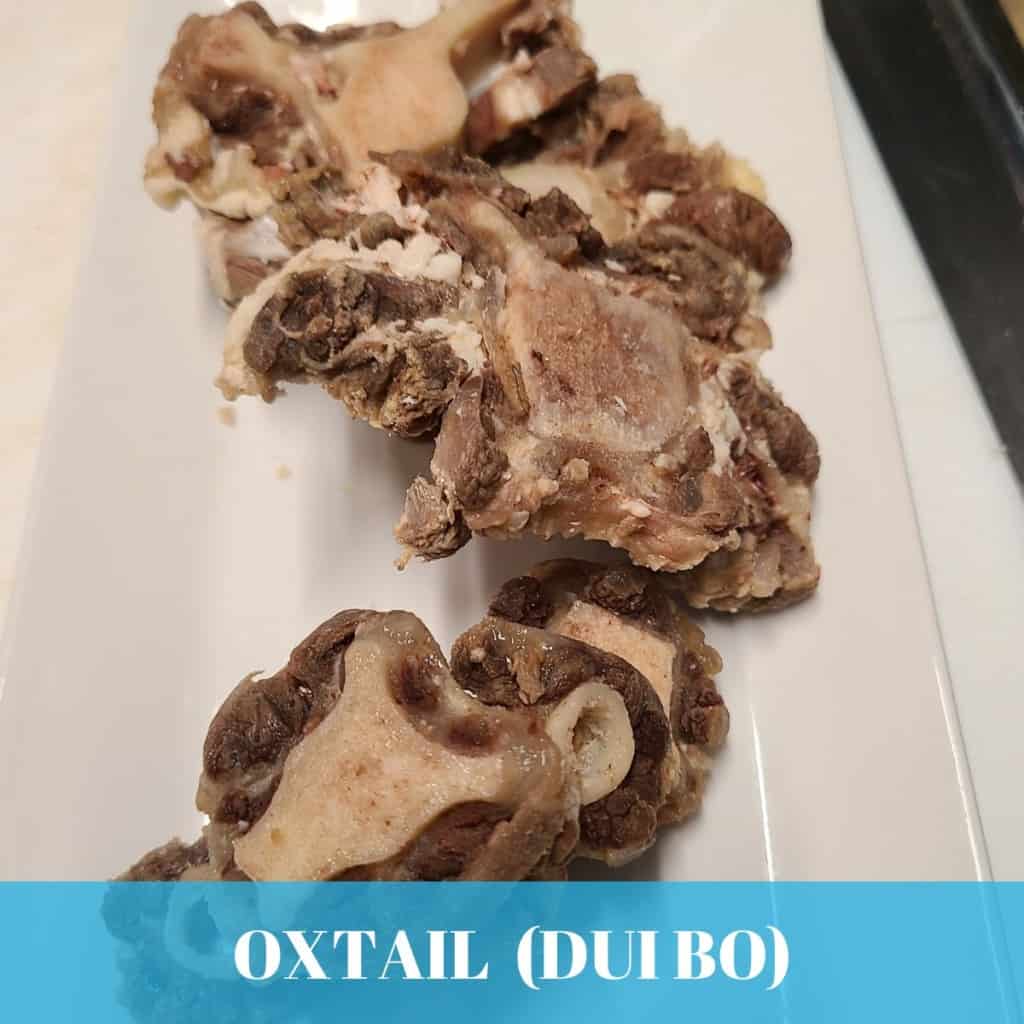
Oxtail, or dui bo, is cut into two inch rounds cross-wise before being added to pho. The bones and cartilage add flavor to the soup broth, while the meat is quite tender. If you love organ meats and believe in its benefit, this is a great addition.
This is not a very common item you might find at the restaurant – oxtail tend to be very expensive, and is prized for its superior nutritional benefits.
You might want to skip this one if you don’t consider yourself a very experimental eater. It might have a strong taste profile.
Meatball – Bo Vien
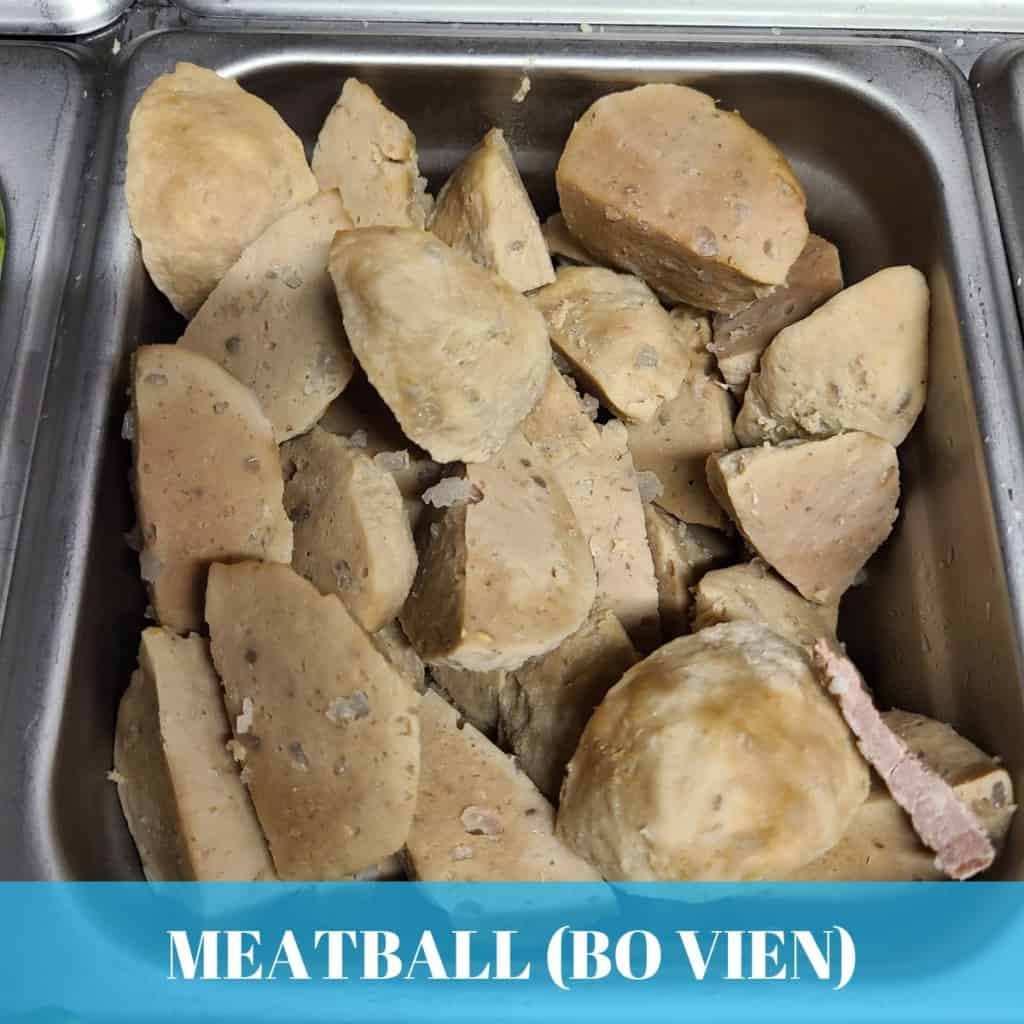
A beef meatball, or bo vien, is made from the shank. The meatballs have tendons and cartilage mixed in as well. If you like meatballs in general, definitely try this one!
Typically these come halved or quartered, as pictured above.
Tripe – Sach
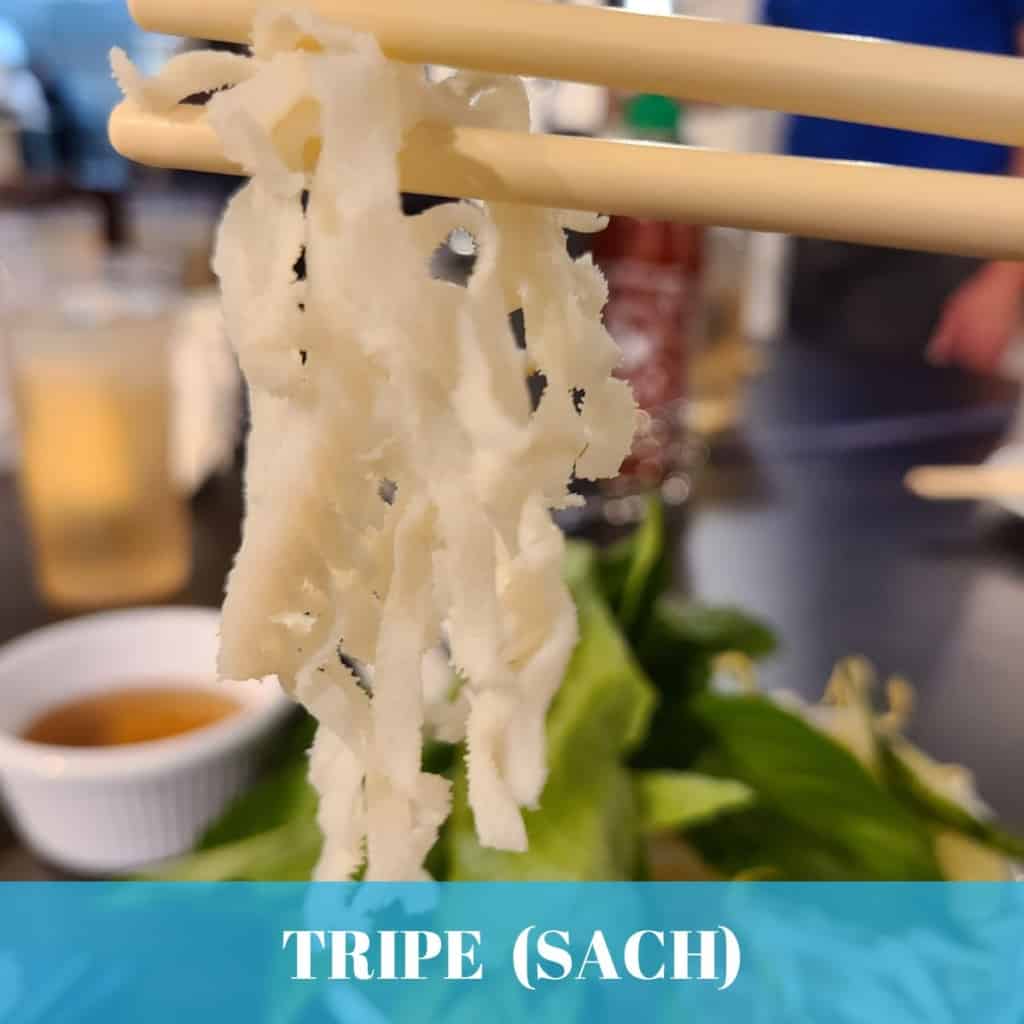
Tripe is the lining of beef, hog or sheep stomach – in Pho, you would most likely be served beef tripe. Beef has a unique texture but not a whole lot of flavor. However, if you’re in the camp of believing in the benefits of eating animal organs, especially from a cow, this is an excellent organ you won’t find anywhere else.
Other meats that also go into Pho:
Typically restaurants might also have choices such as: sliced chicken breast, combination seafood, or vegetarian. Depending on whether or not you want the “authentic” Pho meats or not, you might opt for one of these options.
Sometimes you might find premium offerings such as cubed filet mignon, or lobster tail for your Pho. Other very traditional restaurants might also offer crunchy flank (ve don) – which is basically an untrimmed flank steak made crunchy (uncommon to find this at butcheries in America). It is a tougher piece of flank that still has pieces of the tendon and might have a chewier texture than most Americans might care for.
When ordering seafood pho or vegetarian pho, keep in mind – even though it’s vegetarian, chicken, or seafood – the broth is still the same: beef based. Occasionally you might find a restaurant that will also serve a chicken broth based for chicken Pho, however this is not common. If you are particular about how your Pho broth is made, you might want to ask the server.
Best Meat for Pho – (at the restaurant)
I recommend always getting the Special, or the “dac biet”. This Vietnamese soup usually has a little bit of all the pho meat. This way you can try it all and see what you like! Although the combination might vary from restaurant to restaurant, the most common meats found in Pho Dac Biet (Pho Special), is:
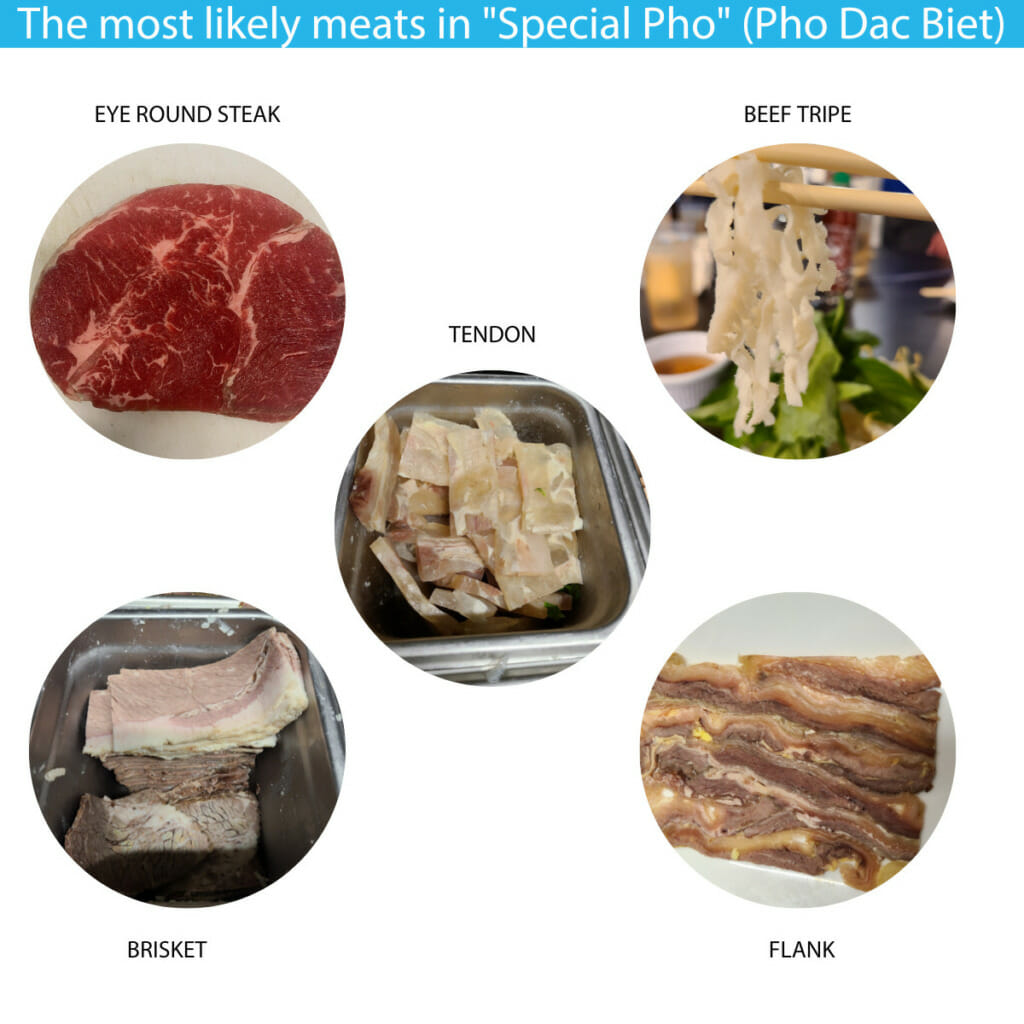
- Eye Round Steak (Tai)
- Flank (Nam)
- Brisket (Gau)
- Tendon (Gan)
- Tripe (Sach)
Note that it’s missing the meatballs and oxtail.
Most Common Pho Meat is Round Eye Steak

If you want to just stick to one type of meat, by far the rare Eye Round Steak is the most common – and about 20% of the time, it’s ordered “on the side”. I highly recommend this – the Pho you get would be so hot when it comes out, that you can “cook” the eye round steak to your liking. I like mine medium-rare. Otherwise it will be well done if you don’t ask for it on a side.
Then the next time you can choose to make your own pho option when you order.
Best Meat for Pho (for the home cook)
There are many different beef cuts that are more readily available at the grocery stores that makes the best meat for pho when you’re cooking at home. For the home chef, there are 3 cuts that we highly recommend for pho: flank, brisket, and filet mignon.
Flank Steak
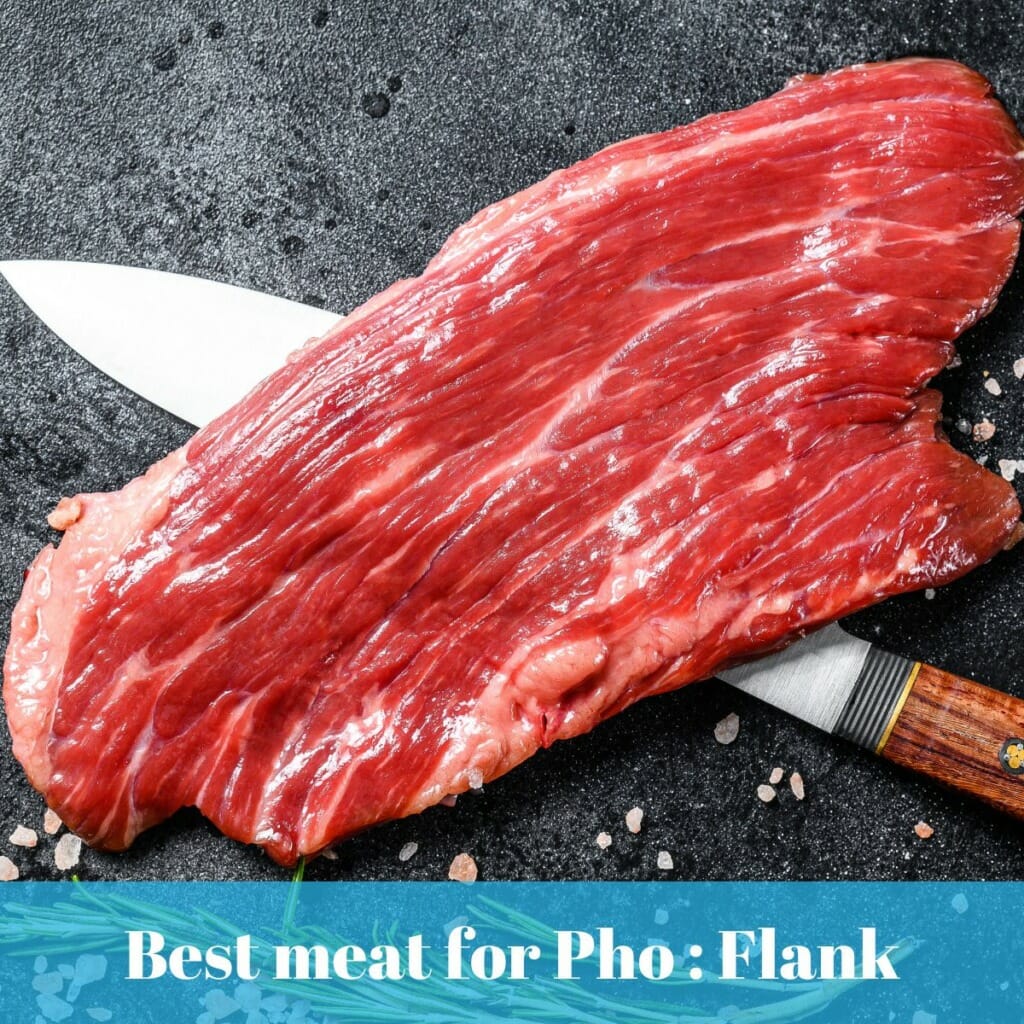
At the restaurant you will most likely be served rough flank, not the flank you would find at the grocery store. It would look a different than the flank image you see above. But flank steak makes an excellent meat for the home chef!
Slice at a 45-degree angle, around 1/4″ pieces, against the grain. When preparing a bowl of pho, arrange the noodles, optional garnishing such as scallions and sliced white onions, and arrange the flank steak in a single layer on top. Bring pho broth to a boil and ladle into your bowl. The piping hot pho broth will cook your flank steak.
Brisket

Brisket is a very large piece of 12-15 pounds of meat on the cow that is normally slow cooked in the oven or smoked over 12-24 hours. Some butcheries and grocery stores will have 1-3 pound portions that you can buy. There are two parts of a brisket – the point, and the flat. You want to choose the flat, where there is less fat but still enough for a flavorful bowl of pho.
Thinly sliced against the grain in 1/4″ slices and arrange in a single layer in your bowl of pho. Ladle boiling broth over it to cook it.
Filet Mignon
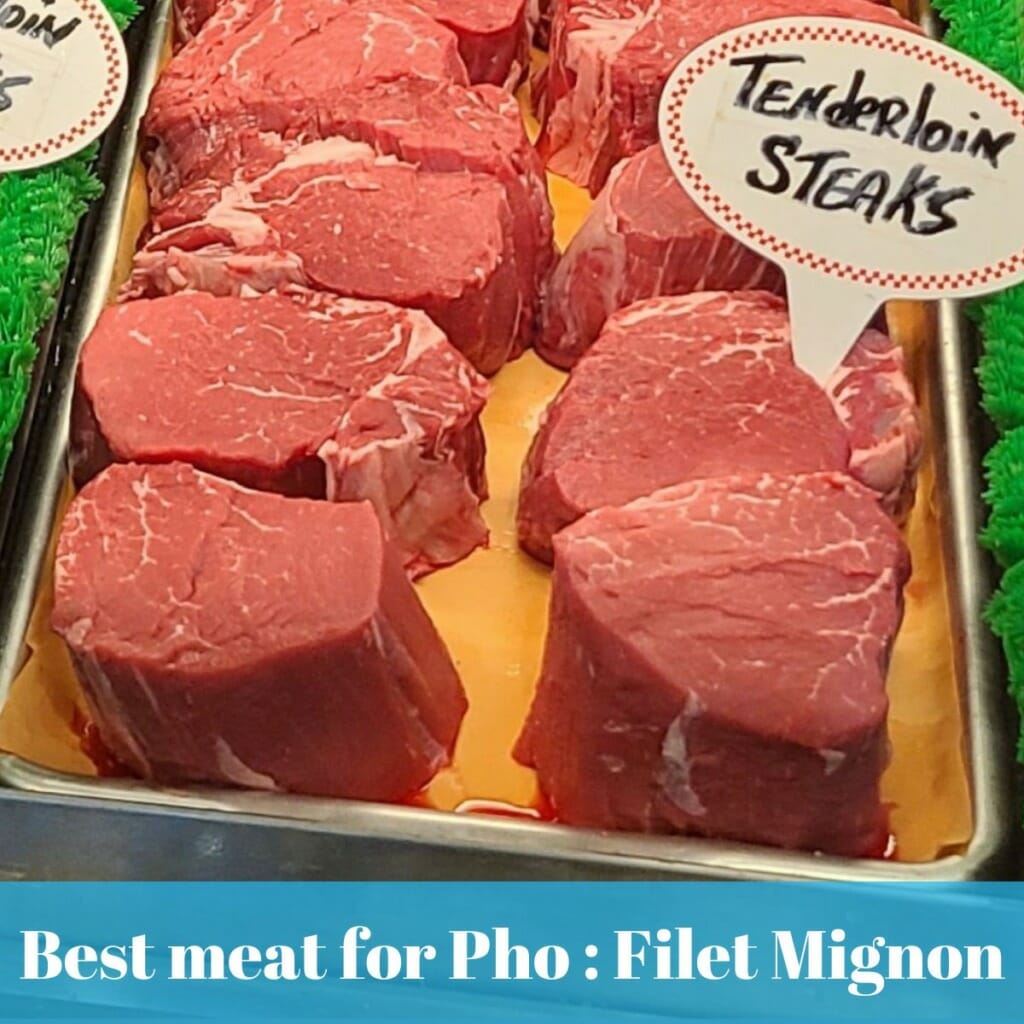
Even though Pho is traditionally served with cheaper cuts of meats such as top round or rough flank, it doesn’t mean you can’t enjoy it with some tender meats! As a matter of fact, I highly recommend it. Some restaurants have even started offering these options – I’ve seen filet mignon, as well as a lobster tail as an add-on for your pho!
For a filet mignon, the best way to enjoy it in your pho is to cube it in 1-inch cubes and ladle broth over it until done ness of choice. To make it medium to medium-rare, I ladle the hot broth into the bowl and immediately bring the cubes to the surface so it stops cooking further. To make it well done, I bury the cubes of filet mignon at the bottom of the bowl and leave it there for a few minutes.
Pho Types
Although a beef broth is most common, sometimes you will find chicken based Pho broth at restaurants. Don’t let the names “vegetarian pho” and “seafood pho” fool you – the broth is still the same (beef based), only the toppings are different.
Beef Pho – most common type of pho. Cooked using beef and beef bones and served with beef meats such as flank, eye round steak, and brisket, as well as organ meats such as tripe and tendon. Some specials might include meatballs and oxtail.
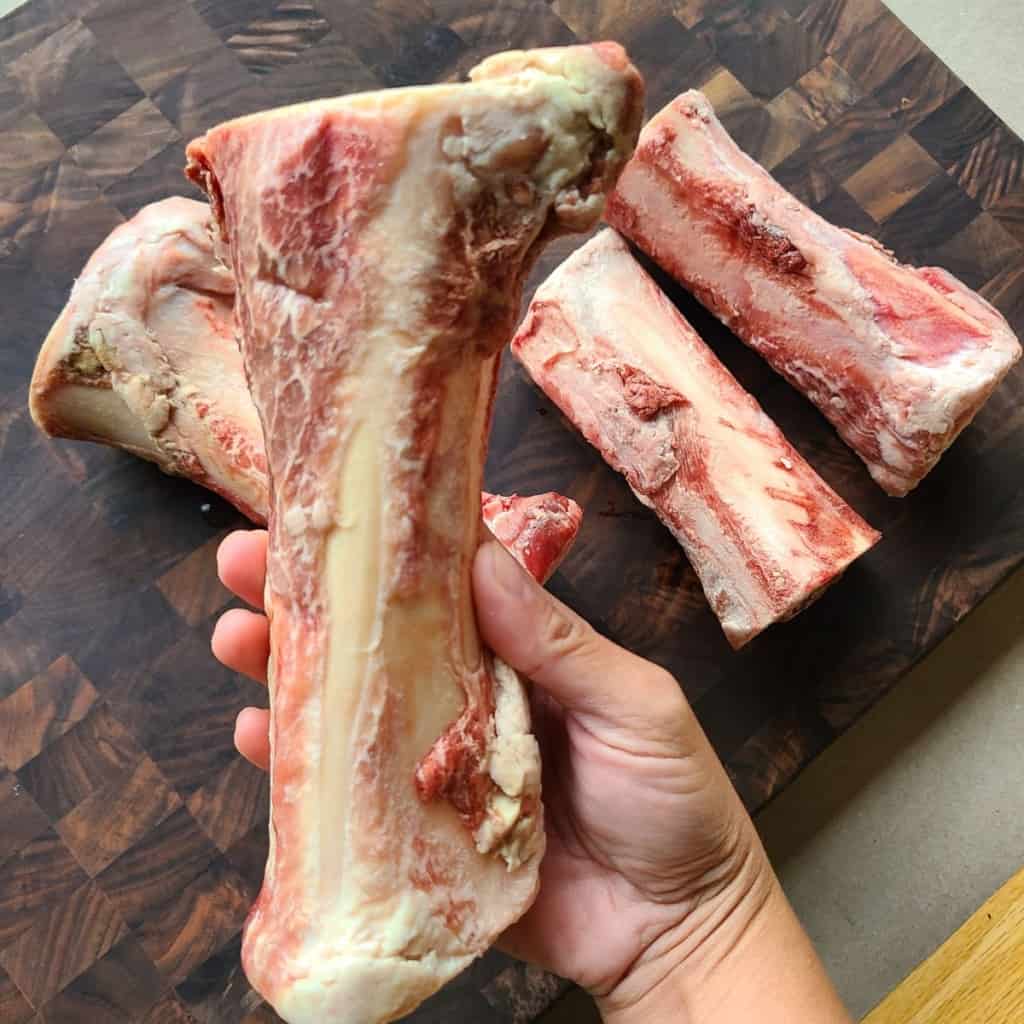
Chicken Pho – For the home kitchen, it is more common to cook chicken pho at home since whole chicken is more readily available at grocery stores than things such as beef bones. Typically a whole chicken is cooked, and this pho is then served with shredded chicken meat. Some restaurants have both beef pho and chicken pho, although this is not common.
Oxtail Pho – not for the faint of heart! Oxtail has a very pungent taste. It is, however, renowned for its superior health benefits. You can make beef Pho and add oxtail to the cooking process to extract maximum flavor and health benefits. Slice it crosswise in small sections for serving.
Vegetarian Pho – don’t let the name fool you. There is no real vegetarian base pho broth that you would find at a restaurant. Although it may be possible to use vegetable stock and pho spices to try and re-create the same flavors of authentic pho at home. This includes cloves, anise, cinnamon, ginger, and cardamom.
In a restaurant setting you are most likely getting a beef-based broth served with vegetables such as broccoli, mushrooms, bell peppers, etc. Even if you don’t see this on a menu, there is probably no reason why a restaurant can’t make a vegetarian pho for you.
Seafood Pho – You can’t make a seafood Pho broth. Fish stock is not common, and just really not a good broth for pho! It is very difficult for the authentic pho spices to come through the fish broth. However, there is no reason why you can’t enjoy your Pho (beef-based) with shrimp or squid!
Is Pho Healthy?
Pho is very healthy for you, for the following reasons:
- it is naturally gluten free, since the noodles are made from rice, not wheat (whereas other noodles such as Japanese ramen and Chinese egg noodle are both wheat based)
- the broth is basically a bone broth
- it is served with organ meats not found anywhere in a typical American diet
- Check out our other article on Is Pho Healthy
How To Eat Pho Like a Pro
Eating pho is an experience that goes beyond simply filling your stomach. The first step is choosing the right pho from the menu at pho restaurants. Once your bowl of hot pho arrives, take a moment to appreciate the fragrant aroma and the beautiful presentation of ingredients.
Start by using your chopsticks and soup spoon to mix the ingredients together. This will ensure that the flavors meld together. Afterwards, take a moment to sip the broth. This is a staple in any pho experience.
Generally, you expect that the broth is aromatic, rich and flavorful. Be sure to taste the broth before deciding whether or not you want to add Sriracha (on Amazon) or Hoisin sauce (on Amazon) to the broth! Too many times I see folks make the error of adding them before tasting the broth – probably expecting a certain taste profile they are used to at home or at other restaurants – and ruin the broth. Taste it first before you start squirting in the hoisin and Sriracha (on Amazon), if at all!
Once you’ve taken a sip, it’s time to dig into the noodles and meats. Remember, in authentic pho restaurants, it’s perfectly acceptable and in fact, a complement, to slurp your pho. Americans might find this strange, but my Vietnamese mother loves it when we slurp our soup – it’s a true complement to her cooking. Much like burping is a complement to the chef in some cultures!
Lastly, don’t forget to use the garnishes which are typically provided on the side. Some common garnishes include lime wedges, bean sprouts, basil, and other herbs.
FAQ
What is the thinly sliced meat in Pho?

The thinly sliced meat in Pho is eye round steak. This is also the most popular cut for a traditional bowl of Pho. You might see it ordered u0022on a sideu0022 and eaten almost raw with spritz of plenty of lime juice on it. u003cbru003eu003cbru003eYou might want to try ordering it on a side, and cooking it yourself to the temperature of your liking by dipping it in your piping hot Pho. Otherwise it comes well done.
What is the white stringy stuff in Pho?

The white stringy stuff in Pho is beef tripe – or the stomach lining of a cow. It has very little taste, but a chewy texture. If you like the health benefits of u0022eating the whole animalu0022, try a bowl of Pho with tripe (or u0022sachu0022)
Is Pho healthy or fattening?

At a restaurant setting, most likely the fat has been skimmed off in your bowl of Pho – unless you specifically ask for extra fat (some people do this). Pho is healthy: the broth is bone broth, the noodle is naturally gluten-free, and it is served with a small amount of meat and organs of your choice.
What is the sauce that goes on Pho?

There are two main sauces that goes on Pho: the black sauce is Hoisin sauce, and the red sauce is Sriracha – you might recognize the red rooster logo on Sriracha.If you’ve had Peking duck dishes at authentic Chinese restaurants, it is commonly served with Hoisin sauce. Sriracha has made its way into mainstream food establishments – you might find it on chicken wings, and on subs at sub shops.
Does Pho detox your system?
Well, pho in itself is not a detox. However, pho can potentially aid in detoxification. This is due to its broth, which is traditionally made by simmering bones and cartilage for hours. This lengthy process extracts nutrients like collagen and minerals from the bones, which can support the body’s natural detoxification process. However, to get the most detox benefits, choose pho with lean meats like eye of round, and lots of vegetables.
It’s important to note that a single dish like pho alone cannot fully detox your system. A balanced diet and healthy lifestyle are also crucial. If need be, you may also need to get a detox product.
Can diabetics eat pho?
The rice noodle found in pho can be a problem for some diabetics due to its high carbohydrate content. For you can try zucchini noodles instead – although restaurants will not likely have this as an option. If you cook Pho at home, you’ll likely need around 2 full zucchini for each bowl of pho.
If you’re eating out, I would just ask for less rice noodles when you order it. I sometimes find that adding cooked beansprouts help with the lack of noodles. To cook it, just bury it at the bottom of the bowl when your piping hot bowl of Pho comes out immediately. Leave it for a few minutes and dig in!
You might also like
Pho Vs. Ramen – The Ultimate Showdown
Vietnamese Spring Rolls Recipe (Goi Cuon)
Ca Kho To: Vietnamese Braised Fish
Are you at a Pho Restaurant? Download Our Cheat Sheet for ordering Pho right now!

